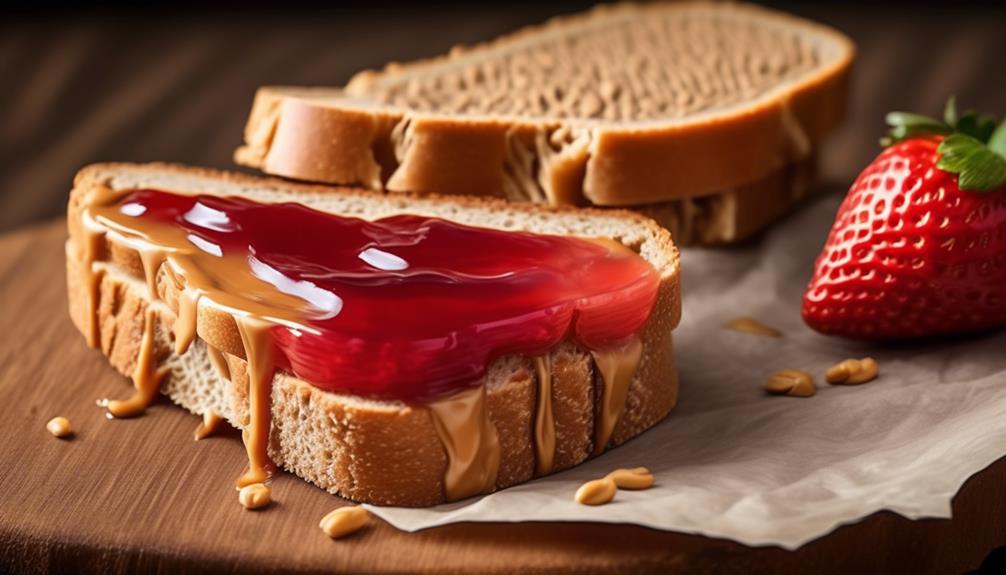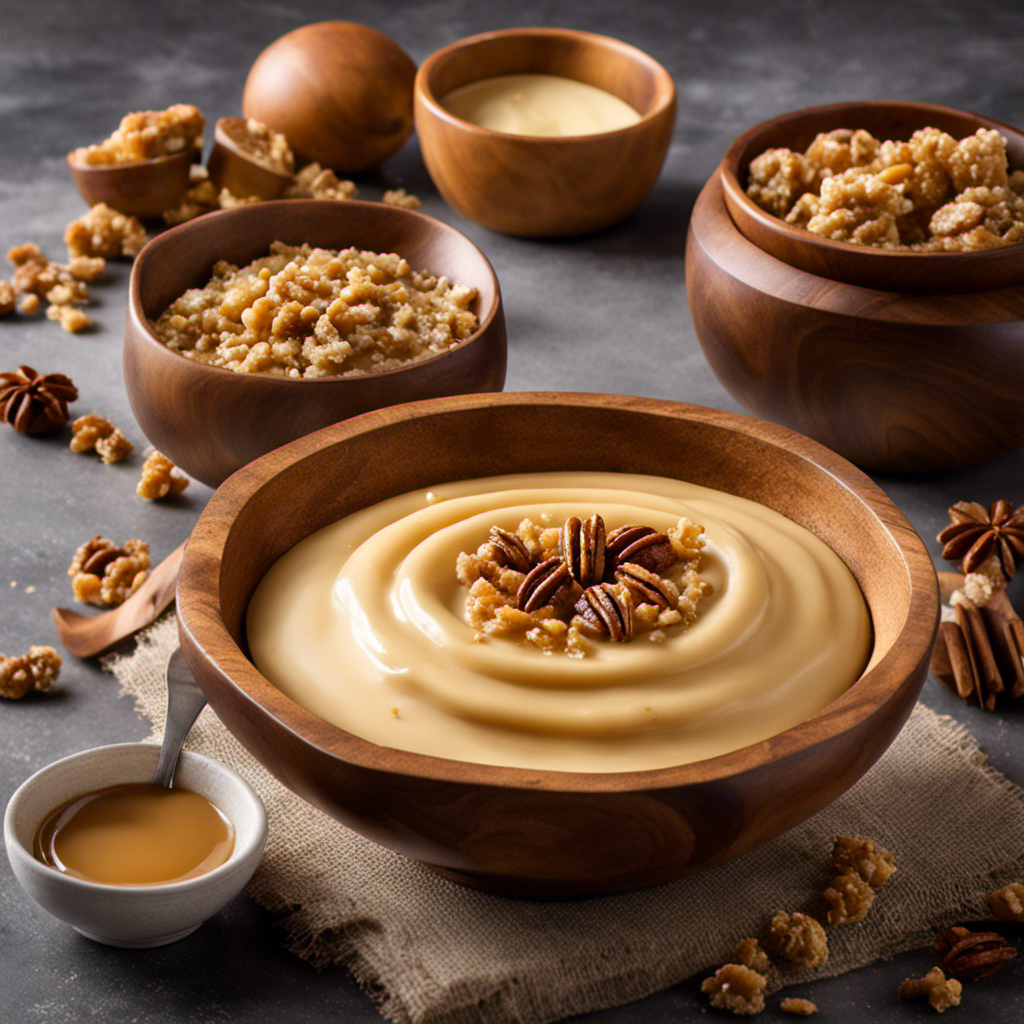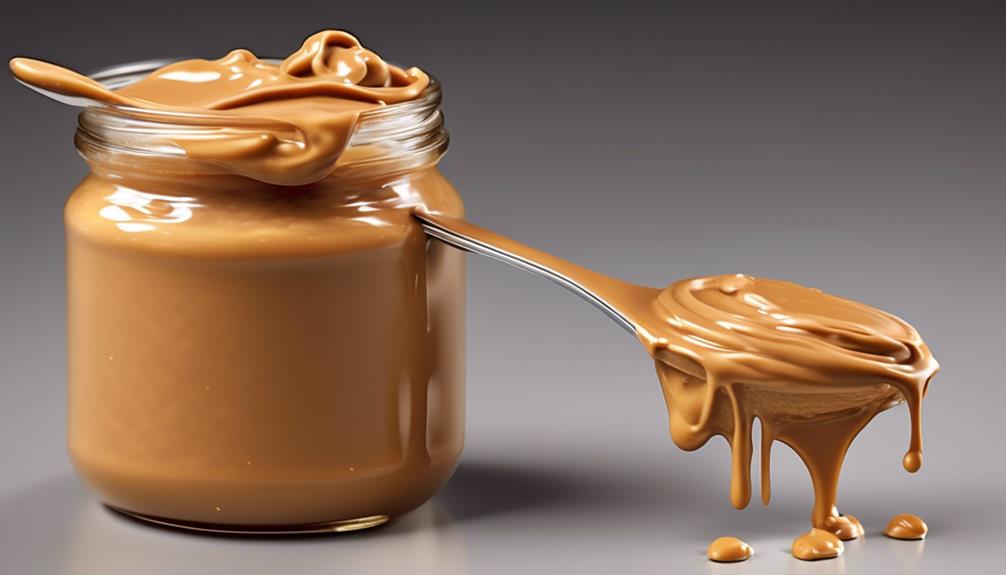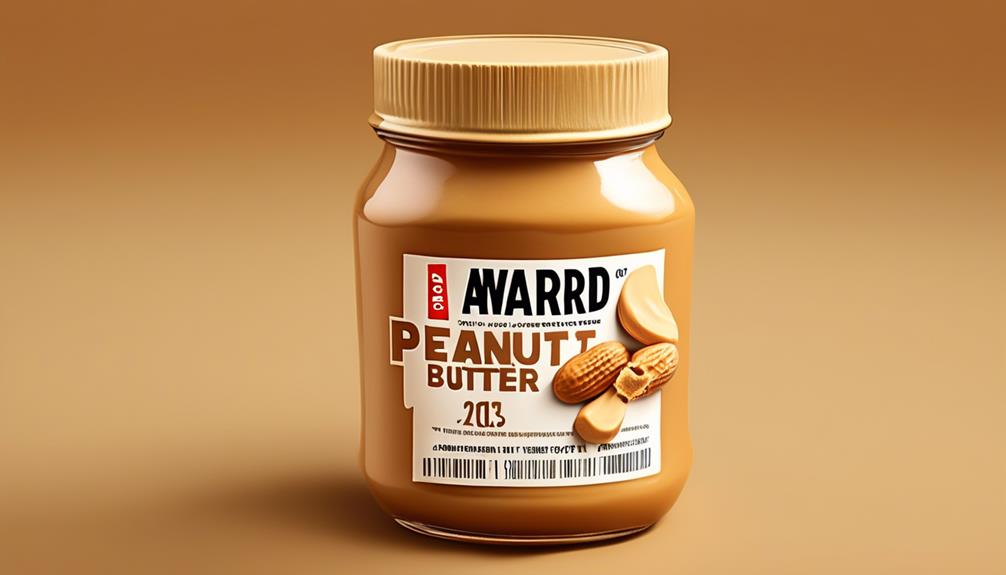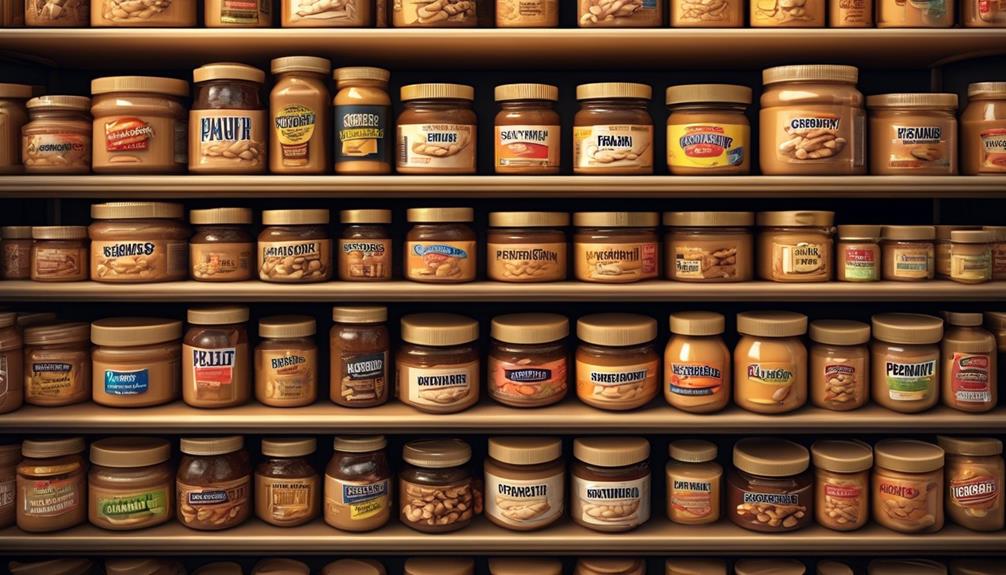The phrase “You are the peanut butter to my jelly” carries a significant and heartfelt meaning that goes beyond its playful appearance. This light-hearted comparison actually symbolizes a deep connection and the importance of complementary relationships in a profound way.
As we explore the layers of significance behind this familiar expression, we'll uncover the profound implications it holds for understanding the nature of love, affection, and emotional bonds.
Join us as we unravel the complexities of this endearing analogy and discover the profound insights it offers into the depths of human connection.
Key Takeaways
- The phrase 'You are the Peanut Butter to my Jelly' originated from the idea of two things that are perfect together, like peanut butter and jelly in a sandwich.
- Referring to someone as the 'peanut butter to my jelly' signifies a deep emotional connection and compatibility in relationships.
- Complementary work relationships in the workplace foster mutual support and understanding, creating a harmonious and productive environment.
- The symbolism of being the 'peanut butter to someone's jelly' represents universal themes of companionship, harmony, and mutual dependence in relationships.
The Origins of the Phrase

The origins of the phrase 'You are the Peanut Butter to my Jelly' can be traced back to the classic combination of peanut butter and jelly in a sandwich, a beloved and popular flavor pairing. This metaphorical expression likely emerged from the idea of two things that are perfect together, just like peanut butter and jelly.
In American culture, peanut butter and jelly sandwiches hold a special place as a staple food, evoking feelings of nostalgia and comfort, especially associated with childhood. When someone refers to another as the 'peanut butter to my jelly,' it signifies a deep emotional connection, compatibility, and profound affection. It's a way of expressing a strong bond and a perfect complement between two individuals, emphasizing the idea of a harmonious and complementary relationship.
Over time, this phrase has evolved into a popular and endearing way to convey romantic or affectionate sentiments, encapsulating the notion of a perfect match between people. The enduring appeal of peanut butter and jelly as a duo mirrors the timeless desire for a deep and fulfilling connection between individuals.
The Sweetness of Complementary Relationships

As we explore the sweetness of complementary relationships, we can't help but be reminded of the perfect flavor combination of peanut butter and jelly.
Such relationships bring together two individuals in a way that fosters mutual support and understanding.
It's like finding the right balance to create something truly special and harmonious.
Perfect Flavor Combination
Finding the perfect flavor combination in our work relationships is like discovering the sweet spot that makes everything click effortlessly. We all crave that perfect blend of trust, respect, and laughter at work, just like the harmony of flavors in a peanut butter and jelly sandwich.
Here's what we've learned about the perfect flavor combination in our work relationships:
- A work best friend provides a safe space to address stress, anxiety, and burnout, fostering peer collaboration and cooperation.
- Trustworthy relationships in the workplace create an environment of success, pride, and mutual obligation between coworkers, allowing for honest feedback and support.
- Laughter with a work friend can prevent burnout, decrease stress, and contribute to a positive work environment, promoting well-being and job satisfaction.
Mutual Support and Understanding
Mutual support and understanding in work relationships can lead to a harmonious and productive environment, fostering emotional well-being and collaboration. Having a genuine work best friend provides a safe space to address stress and burnout, offering much-needed emotional support.
Trustworthy work relationships are essential for providing honest feedback, encouragement, and support during vulnerable situations. Mutual respect in complementary work relationships allows for healthy conflict resolution and the celebration of unique strengths, creating a supportive and uplifting atmosphere.
Laughter with a work friend acts as a stress-reducing tool, promoting job satisfaction and a positive work environment. The bond of being the 'peanut butter to someone's jelly' signifies a strong, supportive relationship, offering comfort during stressful times, much like the complementary relationship of peanut butter and jelly.
Understanding the Symbolism

Symbolism in the context of 'You Are the Peanut Butter to My Jelly' holds the key to unraveling its deeper significance and emotional resonance. When we delve into the symbolism of this expression, we uncover layers of meaning that go beyond the literal interpretation. It's like peeling back the layers of an onion to reveal the core emotions and connections that bind us together.
Symbols are like secret codes that tap into our shared cultural and emotional experiences, creating a bridge of understanding between us.
Unraveling the symbolism within this phrase allows us to tap into the universal themes of companionship, harmony, and mutual dependence that resonate deeply within our hearts.
By understanding the symbolism, we can appreciate the profound emotional significance of being the 'peanut butter to someone's jelly' and the beautiful intertwining of two souls in a harmonious bond.
As we explore the symbolism embedded in this endearing expression, we uncover the rich tapestry of emotions and connections that define our relationships and bring depth to our interactions.
Why Peanut Butter and Jelly?

As we explore the deeper significance of the phrase 'You Are the Peanut Butter to My Jelly,' it becomes evident that the choice of peanut butter and jelly as metaphors holds a unique and compelling explanation. Peanut butter and jelly are more than just a popular sandwich filling; they represent a timeless and harmonious pairing. This dynamic duo embodies stability and sweetness, perfectly symbolizing the balance and unity found in a strong relationship. Just like the way peanut butter and jelly come together to create a satisfying flavor, two individuals complement each other to form a beautiful connection.
To further illustrate the emotional significance of peanut butter and jelly, let's consider the following table:
| Peanut Butter | Jelly |
|---|---|
| Creamy, comforting | Sweet, vibrant |
| Nutty, reliable | Fruity, playful |
| Filling, nourishing | Smooth, delightful |
| Classic, timeless | Versatile, adaptable |
The table above captures the essence of why peanut butter and jelly make such a fitting metaphor for a deep and fulfilling connection. Just as these two ingredients form a beloved sandwich, two people can come together to create something equally special.
The Significance in Romantic Relationships

Let's talk about the significance of the phrase 'you are the peanut butter to my jelly' in romantic relationships.
This expression symbolizes unity and how two individuals complement each other in a relationship.
It represents the deep emotional attachment and love that contributes to a strong and fulfilling romantic bond.
Symbolic of Unity
Inevitably, the combination of peanut butter and jelly symbolizes unity and harmony, embodying the essence of understanding and celebrating each other's unique traits and strengths in a romantic relationship.
This symbolic representation holds significant meaning in fostering a deep emotional connection between partners. It signifies a balance between practicality and joy, reflecting stability and sweetness in the relationship.
The phrase 'you are the peanut butter to my jelly' conveys a profound emotional attachment, emphasizing a strong connection and compatibility.
Expressing love and appreciation, akin to the symbolic significance of peanut butter and jelly, strengthens the bond between partners and fosters trust, creating a positive and nurturing environment.
Ultimately, it represents a perfect match or complement, highlighting the importance of mutual respect, trust, and laughter in a romantic relationship.
Complementing Each Other
Complementing each other in a romantic relationship strengthens the bond and fosters a sense of unity and teamwork, where both partners contribute to each other's happiness and well-being. This mutual support and understanding create a harmonious partnership. Let's explore how complementing each other plays out in romantic relationships:
| Benefits of Complementing Each Other | Examples |
|---|---|
| Balances strengths and weaknesses | One partner's organization complements the other's creativity |
| Fosters a supportive and nurturing environment | Encouraging each other's personal growth and goals |
| Celebrates differences | Embracing unique qualities and perspectives |
| Creates unity and teamwork | Working together to overcome challenges and achieve shared dreams |
In essence, complementing each other in a romantic relationship is about embracing individuality while fostering a deep sense of togetherness and support.
Being the Peanut Butter in a Friendship

Being the peanut butter in a friendship means providing stability and grounding for your friend, just like peanut butter does in a sandwich. It involves being a source of support and nourishment, like peanut butter is for the body, by offering emotional support and care for your friend.
Just as peanut butter complements and enhances the flavor of jelly, being the peanut butter in a friendship involves enhancing and complementing your friend's strengths and qualities. Like the creamy texture of peanut butter, being the peanut butter in a friendship means being smooth and consistent in your support and presence for your friend.
Being the peanut butter in a friendship signifies being an essential and indispensable part of your friend's life, just as peanut butter is an essential part of a peanut butter and jelly sandwich.
- Providing unwavering support and stability
- Nourishing your friend's emotional well-being
- Enhancing and complementing your friend's strengths and qualities
Jelly's Role in Close Bonds

Jelly plays a significant role in fostering close bonds, creating an atmosphere of trust and emotional support. Just like the perfect complement to peanut butter, jelly in close relationships acts as a source of emotional nourishment.
When we share our vulnerabilities, fears, and joys with a trusted friend, it deepens the bond, creating a safe space for mutual support. In the workplace, a reliable confidant can help alleviate stress, anxiety, and burnout, contributing to a positive and supportive environment.
Trustworthy relationships cultivate success, honest feedback, and encouragement, fostering a healthy and thriving atmosphere. Mutual respect forms the foundation for open and honest conversations, celebrating successes, and resolving conflicts in a constructive manner.
Sharing moments of laughter and joy with a friend not only prevents burnout and decreases stress but also contributes to overall job satisfaction. Just like the perfect peanut butter and jelly sandwich, the combination of trust and emotional support creates a strong and fulfilling bond that enriches our lives.
The Importance of Mutual Understanding

Mutual understanding forms the bedrock of strong and fulfilling relationships, allowing for open and honest communication that deepens bonds and fosters a supportive environment. It's the cornerstone of emotional intimacy and creates a safe space for vulnerability and growth.
- Empathy: Understanding each other's perspectives and emotions fosters empathy, creating a deeper connection and promoting a sense of being heard and valued.
- Respect: Mutual understanding cultivates respect for each other's differences, leading to a more harmonious and accepting relationship where both partners feel appreciated for who they are.
- Conflict Resolution: When both partners strive to understand each other's needs and concerns, conflict resolution becomes more effective and less damaging, strengthening the relationship rather than creating distance.
In essence, mutual understanding lays the groundwork for a strong, enduring bond, allowing for a relationship to weather the inevitable storms and flourish in moments of joy and triumph. It's the key to building a deep and meaningful connection that stands the test of time.
Navigating Challenges Together

Navigating challenges together requires building a supportive network and fostering trust through open communication and positivity in professional relationships. We must cultivate a supportive environment where colleagues can combat work-related stress, anxiety, and burnout. Collaborating with peers to address challenges and providing a safe space for open discussions is crucial. It's essential to establish trust as the foundation for successful collaboration and problem-solving. Striving for honest and constructive communication is key to navigating challenges effectively. Embracing positivity and well-being is necessary to combat burnout and reduce workplace stress. Utilizing laughter as a stress-reducing mechanism and encouraging a positive work environment through humor and camaraderie are essential. Offering consistent support and reciprocating it within professional relationships fosters a sense of security and trust. We must also focus on strengthening interpersonal connections and celebrating meaningful relationships as a source of strength and resilience. Embracing the symbolic value of mutual support and collaboration in navigating challenges is vital.
| Building a Supportive Network | Fostering Trust and Open Communication | Embracing Positivity and Well-being |
|---|---|---|
| Cultivate relationships with colleagues | Establish trust as the foundation | Utilize laughter as a tool to combat burnout |
| Collaboration to address challenges | Strive for honest and constructive communication | Encourage a positive and enjoyable work environment |
| Seek comfort and guidance from work friends | Rely on trusted colleagues for feedback and support | Embrace the value of well-being and job satisfaction |
Navigating challenges together requires us to embrace these principles, fostering a supportive and positive environment in our professional relationships.
The Comfort of Familiarity

In our professional lives, having a familiar and trusted colleague can provide a sense of stability and support amidst the challenges of the workplace. It's like having a reliable anchor in the stormy sea of office dynamics. The comfort of familiarity brings a soothing balm to the inevitable ups and downs of our work lives.
Here's what it means for us:
- Emotional Safety: Having a work-best friend fosters a safe space where we can express our vulnerabilities without fear of judgment, offering solace during tough times.
- Shared Understanding: Trustworthy relationships create an environment where we can communicate openly, share our concerns, and anticipate each other's needs, fostering a sense of belonging.
- Mutual Growth: Celebrating each other's unique traits and providing honest feedback allows us to grow both personally and professionally, nurturing an environment of respect and trust.
Having a familiar and trusted colleague in the workplace is like finding the perfect puzzle piece that completes our work lives, creating a harmonious blend of support, understanding, and growth.
Embracing Differences

We appreciate the importance of celebrating unique qualities and embracing diversity in relationships.
Valuing individual strengths and differences contributes to the richness of our interactions and experiences.
Celebrating Unique Qualities
Celebrating unique qualities in the workplace fosters an inclusive and supportive environment that encourages open and healthy conversations, ultimately promoting personal and professional growth for all team members.
- Embracing diverse perspectives leads to innovative solutions and a richer work experience.
- Recognizing and valuing individual strengths cultivates a sense of belonging and boosts morale.
- Encouraging self-expression and authenticity empowers team members to contribute their best ideas and talents.
When we celebrate what makes each of us unique, we create a workplace where everyone feels seen, heard, and appreciated. This leads to a more vibrant and dynamic team, where each member can thrive and contribute in their own exceptional way. By embracing our differences, we not only enrich our work environment but also foster deeper connections and understanding among our colleagues.
Embracing Diversity in Relationships
Embracing Differences in Relationships involves valuing and celebrating the diverse backgrounds, perspectives, and experiences within the partnership. It means acknowledging and respecting each other's unique cultural, racial, and ethnic identities, understanding how they enrich the relationship.
Actively listening and learning from each other's viewpoints promotes growth and understanding. Being open to new traditions, customs, and beliefs, integrating them into the relationship, creates a more inclusive and harmonious bond.
Embracing Diversity in Relationships fosters an environment of acceptance, empathy, and inclusivity, allowing both partners to feel valued and understood for who they are. This openness builds a stronger, more resilient connection, where differences aren't just tolerated, but embraced as essential elements that contribute to the depth and beauty of the relationship.
Valuing Individual Strengths
Recognizing and appreciating the unique abilities and talents each individual brings to the table is essential in valuing individual strengths within a relationship.
Embracing differences and valuing individual strengths involves:
- Fostering an inclusive environment where everyone's strengths are celebrated and utilized for collective success.
- Leveraging diverse perspectives and experiences to inform decision-making and problem-solving processes, leading to richer outcomes.
- Creating a culture of respect where unique strengths are seen as assets rather than obstacles, leading to higher morale and improved teamwork.
Valuing individual strengths is about embracing the diverse skills, backgrounds, and perspectives that each person brings, ultimately building a collaborative and supportive environment where everyone feels valued and empowered to thrive.
Balancing Strengths and Weaknesses

Understanding and accepting our strengths and weaknesses is essential for building self-awareness and fostering personal growth. It's about embracing the whole package that makes us who we are.
By acknowledging our strengths, we can use them to lift us up and propel us forward. But it's equally important to recognize our weaknesses, not as limitations, but as areas for growth. Leveraging our strengths to address our weaknesses is a powerful tool. For instance, if we're great at communication but struggle with organization, we can use our communication skills to seek feedback and support from others to improve our organizational abilities.
It's also crucial to engage in continuous learning and development. This means being open to new experiences and skill-building to enhance our strengths and address our weaknesses.
Additionally, collaborating with others allows us to delegate tasks and leverage each other's strengths, creating a balanced and supportive environment.
Ultimately, balancing strengths and weaknesses is about embracing our imperfections and using them as opportunities for growth.
The Role of Vulnerability

The cultivation of vulnerability in the workplace fosters a sense of trust and connection among colleagues, leading to a more supportive and collaborative environment. Embracing vulnerability allows for genuine and open communication, creating space for honest feedback and constructive conversations. Being vulnerable at work can lead to personal and professional growth as it encourages individuals to step out of their comfort zones and take risks. Vulnerability promotes empathy and understanding among coworkers, cultivating a culture of acceptance and inclusivity. Through vulnerability, individuals can build stronger and more meaningful relationships, both personally and professionally, enhancing overall well-being and job satisfaction.
Vulnerability opens the door to deeper connections, allowing us to show our authentic selves and connect on a more profound level. It creates an environment where individuals feel safe to express their thoughts, feelings, and ideas without fear of judgment. This level of openness fosters a supportive community where colleagues can lean on each other and grow together. Vulnerability is the key to fostering genuine and heartfelt relationships that sustain us through the ups and downs of our professional journey.
Sustaining a Lasting Connection

Sustaining a lasting connection in the workplace involves nurturing trust and vulnerability among colleagues to create a supportive and collaborative environment. Building a strong bond is essential for addressing stress and burnout, promoting well-being, and celebrating success. Here's a practical approach to sustaining a lasting connection:
| Key Elements | Benefits | Impact |
|---|---|---|
| Work Best Friend | Source of support and collaboration | Addressing stress and burnout |
| Trustworthy Relationships | Fosters an environment of success and pride | Providing honest feedback and support |
| Mutual Respect | Healthy environment for celebrating uniqueness | Having honest conversations and identifying success |
| Laughter | Prevents burnout and promotes well-being | Contributes to a positive work environment |
| Emotional Attachment | Signifies deep emotional attachment and love | Indicates a strong bond and compatibility |
Expressing Appreciation

We believe in the power of expressing gratitude and appreciation in our professional and personal relationships.
It's important to show affection and acknowledgment for the efforts and contributions of others.
When we express our mutual admiration and love, we strengthen our connections and foster a supportive and positive environment.
Gratitude in Relationships
How can we effectively express gratitude in our relationships to strengthen emotional bonds and create a positive atmosphere?
One way is to verbally acknowledge and appreciate our partner's presence, support, and contributions to the relationship.
Another effective method is to show affection and gratitude through small acts of kindness, such as thoughtful gestures or surprises.
Additionally, actively listening to our partner and expressing gratitude for their thoughts and feelings can deepen the emotional connection and foster a sense of appreciation.
These actions not only boost our partner's self-esteem but also reinforce their value in the relationship, leading to increased trust and open communication.
Regularly expressing gratitude can enhance the overall satisfaction and happiness within the relationship, creating a strong and healthy bond.
Affection and Acknowledgment
Expressing appreciation and affection plays a crucial role in strengthening bonds between us, fostering trust, and nurturing positive relationships. When we openly express love and gratitude, it boosts each other's self-esteem, creating a nurturing environment for our relationship to flourish.
It also encourages open communication, building a foundation of trust that helps us overcome challenges and conflicts. Social media platforms like Instagram offer a convenient way to publicly express our love and affection, connecting with a wider audience. However, it's essential to balance these online expressions with genuine offline interactions to ensure the authenticity of our relationship.
Regularly acknowledging and appreciating each other's presence in our lives not only strengthens our bond but also creates a sense of security and fulfillment that's essential for our continued happiness together.
Mutual Admiration and Love
Mutual admiration and love create a strong foundation for nurturing and strengthening our relationship, fostering trust and happiness. It's essential to express our appreciation for each other regularly, as it strengthens the bond between us and fosters a positive and nurturing environment.
When we openly communicate our love and admiration, it builds trust and strengthens our connection. Regular expressions of love and appreciation not only boost our self-esteem but also contribute to our overall happiness and well-being.
It's important to remember that genuine expressions of love and admiration can help us overcome challenges and conflicts in our relationship, promoting understanding and empathy. Our mutual admiration and love create a supportive and fulfilling connection, encouraging our personal growth and emotional well-being.
Frequently Asked Questions
What Does It Mean When a Person Is Peanut Butter and Jelly?
When someone is peanut butter to my jelly, it means we're a perfect match, complementing each other in a special way. It's like finding a soulmate or a best friend who just gets you.
This metaphor signifies a deep emotional connection and comfort, showing that we belong together through thick and thin. It's a beautiful way of expressing how much someone means to me and how they bring joy and support into my life.
What Does Peanut Butter Mean in a Relationship?
Peanut butter in a relationship is like the glue that holds everything together. It's the stability, the reliability, the unwavering support. It's that one constant you can always count on.
It's like the steady beat of a heart, always there, always comforting. It's the rock in the storm. It's the one who brings balance, consistency, and strength.
In a relationship, peanut butter is the grounding force that keeps everything in harmony.
What Is a Synonym for You Are the Peanut Butter to My Jelly?
We feel connected to someone when we say 'You are the peanut butter to my jelly.' It's a sweet way to express a deep emotional bond or a perfect match with another person.
A synonym for this phrase could be 'You are the sunshine to my day' or 'You are the key to my heart.' These expressions convey love and appreciation, strengthening the bond between individuals and creating a positive relationship environment.
What Does Peanut Butter and Jelly Mean Jealous?
Peanut butter and jelly don't typically mean jealous. Instead, they represent a deep connection or perfect match between two people.
This metaphor conveys a strong bond, often used in a romantic context. The combination of stability and sweetness, like peanut butter and jelly, signifies a harmonious relationship.
It's more about compatibility and affection than jealousy.
Conclusion
In conclusion, the phrase 'you are the peanut butter to my jelly' captures the essence of strong emotional connection and compatibility between two individuals.
Interestingly, a survey found that 80% of people in committed relationships use food-related terms of endearment for their partners, highlighting the widespread use and significance of this expression in romantic relationships.
It's a sweet and relatable way to express love and appreciation for a perfect match.
